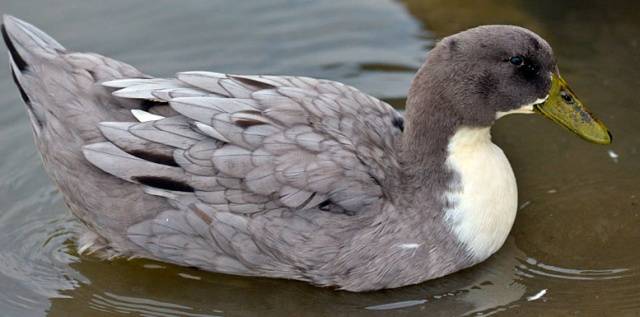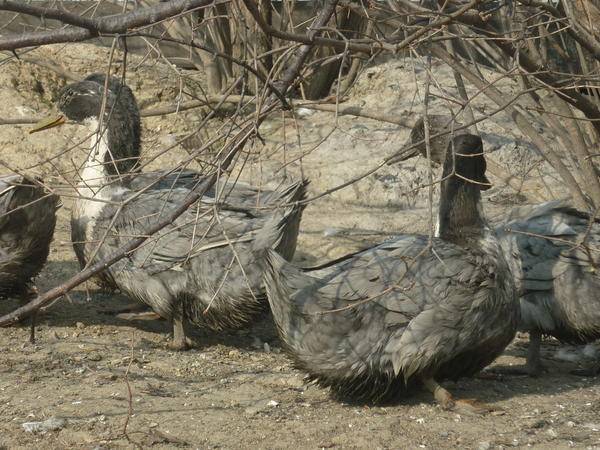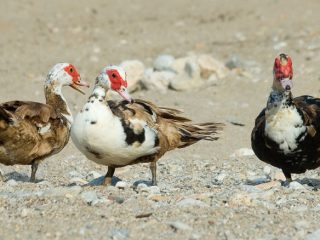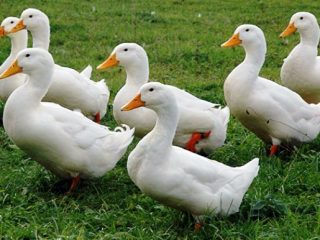Content
So-called duck breed The blue favorite is actually a broiler cross of ducks intended for growing for meat. It is officially believed that the cross was bred on the basis of the Peking duck with an admixture of Bashkir and black white-breasted, but the color of the ducks of the favorite breed is very similar to the color of the real breed of ducks “Swedish blue duck”. Perhaps the second parent breed of this cross is the Swedish Blue.
The cross is completely “fresh” and, in fact, still experimental. More precisely, this is generally an intermediate result, which turned out to be very successful. Theoretically, the advertisement promises 7 kg of live weight for the drake.
The fact that one of the breeds involved in the breeding of the Blue Favorite was the Swedish Blue is also supported by the splitting of colors in the offspring of ducks of the Blue Favorite breed. In the second generation, ducklings of the favorite breed can be not only blue, but also black, dark blue, light blue, fawn, brown, white and various variations of intermediate colors.
For comparison. The official standard for the Swedish Blue Duck is blue only, but Swedish ducks can also be black, silver and fawn. Which suspiciously coincides with the color options of the blue favorite.
After this, it is enough to remember that the breed of Bashkir ducks is in fact purebred Peking ducks, in which the wild color gene suddenly began to appear, and all the color variations of the blue favorite become understandable. No mysticism or telegony. Strict color genetics.
You also need to take into account that the blue color is a black color with a lightening gene. Which, by the way, is not found in any of the official source breeds. That is, when crossing two blue specimens, the appearance of at least 25% black individuals is guaranteed.
It is not recommended to crossbreed black ducks of the Blue Favorite breed with each other, since in this case it is impossible to obtain a blue color. No wonder. If a bleaching gene is present in the genotype, it will always appear in the phenotype. If an individual is black, it means that it does not have the lightening gene.
At the same time, it is not very advisable to cross blue individuals with each other, since the fertility of the eggs will be lower. And, more precisely, the clarifier gene in the homozygous state is lethal for the embryo. An embryo with such a set of genes will die as soon as it begins to develop. If you set a goal duck breeding in color, it is better to cross blacks with blues. In this case, with high egg fertility, you can get 50% blue ducklings and 50% black ducklings.
When crossing two blue individuals, the result will be 50% blue ducklings, 25% black ducklings and 25% rotten eggs. This is with ideal 100% fertilization. Since not all eggs in birds are fertilized, the resulting number of ducklings will be even smaller.
Description of the Blue Favorite duck breed
The Favorite duck breed is very large in size, significantly exceeding the size of the parent breeds. And this circumstance again speaks in favor of crossing genetically widely separated breeds of ducks.In principle, it could be the Peking and the black white-breasted, but the latter does not have the lightening gene.
The favorite is a large stocky duck with a dense build and an elongated body. The legs, adapted to withstand significant weight for ducks, are short, powerful and widely spaced.
The color of the legs and beak depends on the color of the individual, but blue ducks of this breed usually have almost blue beaks.
The advertised weight of the favorite drake of 5 kg can only be achieved through heterosis by crossing the Pekin with the White-breasted or Swedish. The Bashkir duck is still too close to the Peking duck. However, a more optimistic advertisement promises a weight of 7 kg, that is, the weight of an Indian drake, which is hardly realistic.
A duck weighs up to 4 kg. There is also controversy regarding her egg production. Somewhere you can find the figure of 150 eggs per year, somewhere 120, and somewhere 100. Most likely, the number of eggs laid depends on the diet. When feeding the breeding duck stock with compound feed for laying hens, the number of eggs will be maximum, since the vitamins and microelements added to this feed stimulate ovulation in birds.
It is better not to use a poorly balanced diet from home-made feed, since it is an industrial cross.
Since the Blagovarian cross is split according to color, in addition to blue, there is also another branch of this cross: the red favorite. Apart from the colors, these branches of crosses are no different from each other. But, according to reviews from poultry farmers who bought hatching eggs from the Blagovarsk poultry farm, the eggs that hatched in incubators into ducklings covered in red feathers were marked “Kr.”So it is quite possible that the red color is bred not as an outlier from the general mass of ducks of the favorite breed, but as a completely independent branch.
The favorite duck has completely lost its brooding instinct, so its breeding on private farmsteads is possible only through a hatching egg or by placing eggs under other laying hens.
However, in crosses the splitting occurs not only in color, but also in productive characteristics, therefore, to guarantee the production of a large meat duck, the hatching egg will have to be purchased from the direct producer of this cross.
But since the desire of the people to get offspring in their own backyard is ineradicable, buyers of hatching eggs after hatching ducklings always have a question: how to distinguish a duck from a drake.
Determining the gender of favorites
The blue favorite duck is practically indistinguishable in color from the drake even in adulthood. Except that the drake has a slightly darker head. But at the age of two months, the favorites, like other mallards, have the same color. Therefore, you will have to wait until the young go through the juvenile moult and acquire features that distinguish a drake from a duck, in particular, crocheted feathers in the tail area. But in this case, profitability decreases, since the favorite ducks already reach a weight of about 3 kg by two months.
In addition, if you slaughter the young animals later, a lot of feather stumps remain in the skin. This is the main reason for complaints about the breed. Most likely, the fact is that the owners, wanting to leave part of the livestock for breeding, waited until the ducks moulted.
There is another way to determine where the drake is and where the duck is. Various quacking sounds can be clearly heard in the video.
Ducks quack loudly and drakes “whisper.”All you have to do is catch a young duck and listen to how loud it makes its noise to determine its sex. So there is no need to wait for the juvenile molt.
They are no more quiet than any other mallards: after they have eaten.
Incubation of duck eggs
The blue cross is still a rare favorite, but the ducks have an unusual color and attract exotic lovers. It is much more convenient to transport hatching eggs over long distances than live ducks. In addition, since favorite ducks do not consider it necessary to hatch ducklings, those owners who want to get offspring from them at home are forced to use egg incubation.
When receiving offspring from their own livestock, the duck egg is collected within 5 - 7 days. The eggs are not washed, but they must be clean when placed in the incubator. Therefore, they try to collect eggs as often as possible so that the ducks do not have time to dirty them. This breed is a big fan of burying eggs in the litter.
After laying the eggs in the incubator, the hatching scheme for ducklings is similar to the scheme for any other breed of mallard.
After hatching, the ducklings are moved to a brooder. Although the advertisement claims that the hatchability of the favorite ducklings is very high, the veracity of this statement raises reasonable doubts, primarily due to the color. Plus, bird eggs cannot withstand strong shaking. If the hatching egg has traveled a long way to reach the buyer, there is a possibility that very few ducklings will hatch simply because the package was shaken a lot along the way.
The hatched ducklings are in good health and safety. If the eggs have not been contaminated by the infection yet at the manufacturer. However, any poultry eggs, and not just favorites, should be purchased from a trusted manufacturer.
Reviews from owners of blue favorites
Reviews range from “excellent ducks, very pleased” to “completely do not correspond to the stated characteristics.” A couple of examples of such reviews.
Let's sum it up
Such discrepancies are possible in three cases:
- The favorite is still only a breed group. In breed groups, individuals are often split into their original breeds, so in fact they may end up with Bashkir ducks with a blue color;
- if fed incorrectly, an industrial cross may simply not reach the stated weight, since it needs factory-made feed for broilers, and not homemade mash;
- resellers, who themselves had little knowledge of the breeds or wanted to make extra money, sold the wrong eggs.
To avoid such problems, it is better to purchase eggs for the incubator from the factory that produces the blue favorite cross. Moreover, this is the only place where these birds are bred in large quantities. You also need to follow the feeding regime and diet. And, most likely, adult drakes will gain their 5 kg, and ducks 4 kg.



















We bought Blue Favorite ducklings and wanted to raise them for meat. At 56 days, they killed two drakes (processed carcasses weighing 2 kg each). They decided to raise the rest further until they moulted. But even then my husband didn’t have the heart to chop them. In November (at 5 months), the ducks started flying, we gave them a greenhouse, but they are there They just ate and laid eggs, spent the night in the enclosure, in the snow. They stopped laying eggs at the beginning of January, when severe frosts set in. All winter, with the exception of (-25-30), they spent the night in the enclosure. They started laying eggs again at the end of February. And they continue to lay eggs to this day. During this time, more than 100 ducklings were hatched in the incubator, with another 100 hatched on the way (a little less will hatch).We sold 91 ducklings (those who bought them for the first time contacted us again, some took more ducklings, some with eggs (sent to relatives). Now we have the remaining 9 ducklings growing, they are 1 month old. We are happy, those who bought ducklings from us are also happy ( they grow quickly, don’t get sick, eat everything they give). Yes, ducks lay eggs every day (from 11 ducks 10-11 eggs a day). The egg is very tasty and nutritious. Now one of the ducks is sitting on the eggs, waiting for hatching ducklings the other day.
Well, I don’t know, I left a couple of favorites and a couple of Ukrainian steppe, we walked with each other, the favorite has been sitting on the eggs for 25 days, ovoscoped the eggs on days 7 and 21, everything is fine there, we are waiting for the babies.